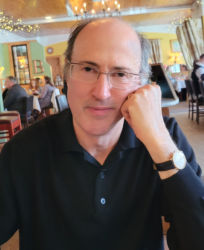Jay Jacobowitz: It seems the concept of buy-local would be easy for everyone to accept, but taking action to bring it about may be a different story.
Michael Kanter: Yes. I don’t think I’ve ever heard a local businessperson say, “No, we don’t believe in the buy-local movement.” But some businesses are shy about actually promoting it, in a sort of, “We don’t like to toot our own horn” attitude. We focused on inviting those that were comfortable being imaginative activists. Sometimes you can get a lot done with very few people who have that drive to improve the business climate in their communities. We also encourage our retail members to source high-quality products that aren’t available everywhere, and not be “cookie-cutter” businesses carrying only the more mainstream products.
To help overcome any reluctance, we encouraged local businesses that, rather than focus on any bad stories suggesting chain stores are our enemy, we focus fully on the effort to get people to move more of their purchases to local independents, and to talk about the good things that local independents are doing. There is no desire or expectation that people will move all of their shopping to local independents. Far from it. But we call this an opportunity to “Shift Your Shopping!” by some significant percentage.
JJ: How hard is it to do that? Isn’t it difficult to find and use smaller vendors?
MK: Well, yes. At Cambridge Naturals, we actually may have to tone it down a bit now. With over 600 vendors, it’s driving us nuts with things like slower delivery times, a lot of money tied up in small vendors, and a huge number of invoices. But having so many unique items is part of what keeps us interesting. Customers find things they didn’t know existed. Staff get excited about those unique items and they get behind them. Part of the challenge is to keep staff informed about all of the items we are bringing in and why we have chosen them.
JJ: Of course, offering unique products is just one aspect. What else can you do as an independent?
MK: We like to say that as a business you need to either “Stand out or watch out!” As an independent business, curating the product selection matters a great deal, as does figuring out how you are going to market each of those unique items. How are you going to shape your customer service? What are you going to require of your employees? It’s ramping up all those things. Most shopping experiences tend to be routine. By creating a shopping experience that is dynamic, informative and supportive, you can distinguish your business from most others. People crave that attention and connection. Providing a really engaging shopping experience also enhances one’s community and collective happiness.
JJ: So, you empower your people to engage with your customers on a deeper level. Is there a downside to that?
MK: We’ve been successful at raising the level of our shopping experience so that people seek us out; sometimes to the point of distraction. We have to be careful we don’t get too involved in any one individual customer and forget other customers or the other work that needs to get done!
JJ: What do you do to convince your team to raise their game?
MK: You have to communicate the passion you started your business with, to insist to your team that this is a noble profession. We do a lot of training around modeling awesome customer service and how not to get rattled by customer complaints, but to take those as a gift that can enhance your business. Sometimes, customers notice important things you don’t. It is about being demonstrably joyful.
Years ago we changed my title to Chief Visionary Officer. I seek out the trends and directions the industry is going in. In particular, the business part of my role is to help uplift our awesome team, including friendly teasing and encouraging laughter. Retail is actually really challenging for so many different reasons. It’s hard work and requires great patience, tolerance and theater!
As I said, you have to show your people that what they are doing is noble work. Communicating to your team that they are not just selling product, but rather a vision of health and wellness, is vital. It is critical in today’s retail environment to be able to be fully present and joyful on the floor with customers.
JJ: You are in your 13th year of Cambridge Local First. What was it like when you started out?
MK: We started with 12 to 15 people at first. We had one founding member, who was totally enthusiastic, and a real cheerleader. He helped keep us motivated and on task. We met once a month for the first several years. We challenged ourselves to create events and a directory of local independent businesses, and to align our movement with local independent banks that are struggling to compete with the nationals. And very importantly, we spoke with our local elected officials. We communicated the importance of the buy-local concept and the idea that they should support us in their endeavors.
JJ: Did people get that right away?
MK: You have to realize that local governments aren’t going to give up on the national chains. So we emphasized to them that, if you want to have an interesting, vibrant community you need local independents to survive and thrive. We educated ourselves and our elected officials about the local money multiplier-effect that proves dollars spent at local independents circulate within the community at a much higher rate than being filtered first through publicly traded national chains. That is a powerful financial incentive to keep emphasizing.
JJ: What are some of the challenges with the core buy-local group?
MK: When we started out, during the first six months, we discussed often why we wanted this group to succeed. We said, “To create a better community,” and “To help build small local economies.” One of the founding members, an owner of a longtime bookstore said, “I want my business to grow.” We said, “Oh, yeah, that’s a really good point.” It is important to stay focused on the business part. Help our teams to grow, and help us look down the road to the future with a positive attitude. Today, Cambridge Local First is still going, but we’re in a bit of a lull. It is hard to bring in young business owners, who are wrapped up in getting their own efforts off the ground. Fortunately, the local-economies movement and message has really resonated with our community and customers.
JJ: What would you say are the big lessons you’ve learned from your efforts to build buy-local in Cambridge?
MK: That it is not only for lack of cleverness that many of us haven’t become bigger businesses. Rather it is with intention and by design. It is who we want to be. If we do our job right, we will likely succeed. And, we are seeing encouraging evidence of that after all these years.
Lately we have had many “complaints” from customers that go pretty much like: “Your store is a total problem for me. Every time I go in, I spend all my money there!” We say, “Don’t worry, we won’t cut you off.” Or, my latest favorite from a local writer: “Every time my wife goes in, she buys out half the store.” My response to him was, “Well, what’s wrong buying out the other half?” We love these so-called complaints, because they tell us we are doing a great job.
Finally, in business after 45 years, we never assume anything. There have been, and still will be, no end of challenges. You can never rest on your laurels. Today is one day and tomorrow we have to put on another great show. How do we consistently make people both inside and outside our business feel good, and ensure they come back and rave to their friends about us? We have to have the right answer to that question every single day!
JJ: Thanks for taking the time to share your wisdom with us.
MK: My pleasure.
Helpful Buy-Local resources If you would like to learn more about starting a buy-local movement in your area, the American Independent Business Alliance (www.amiba.net), and the Business Alliance for Local Living Economies (www.bealocalist.org) have resources to work with local networks around the country. In addition, two outstanding local economy organizations are Arizona Local First (www.localfirstaz.com) and Grand Rapids Local First (www.localfirst.com). JJTell us your story! Perhaps you have experience developing your own buy-local movement in your trade area. If you would like to tell us about your experience, so that we may share it with independent natural products retailers around the country in a future issue, please write to Maggie Jaqua at maggiejaqua@wfcinc.com. We want to spread the word of your success and help others follow your lead!
 Jay Jacobowitz is president and founder of Retail Insights®, a professional consulting service for natural products retailers established in 1998, and creator of Natural Insights for Well Being®, a holistic consumer marketing service designed especially for independent natural products retailers. With 40 years of wholesale and retail industry experience, Jay has assisted in developing over 1,000 successful natural products retail stores in the U.S. and abroad. Jay is a popular author, educator, and speaker, and is the merchandising editor of WholeFoods Magazine, for which he writes Merchandising Insights and Tip of the Month. Jay also serves the Natural Products Association in several capacities. Jay can be reached at (800)328-0855 or via e-mail at jay@retailinsights.com.
Jay Jacobowitz is president and founder of Retail Insights®, a professional consulting service for natural products retailers established in 1998, and creator of Natural Insights for Well Being®, a holistic consumer marketing service designed especially for independent natural products retailers. With 40 years of wholesale and retail industry experience, Jay has assisted in developing over 1,000 successful natural products retail stores in the U.S. and abroad. Jay is a popular author, educator, and speaker, and is the merchandising editor of WholeFoods Magazine, for which he writes Merchandising Insights and Tip of the Month. Jay also serves the Natural Products Association in several capacities. Jay can be reached at (800)328-0855 or via e-mail at jay@retailinsights.com.









